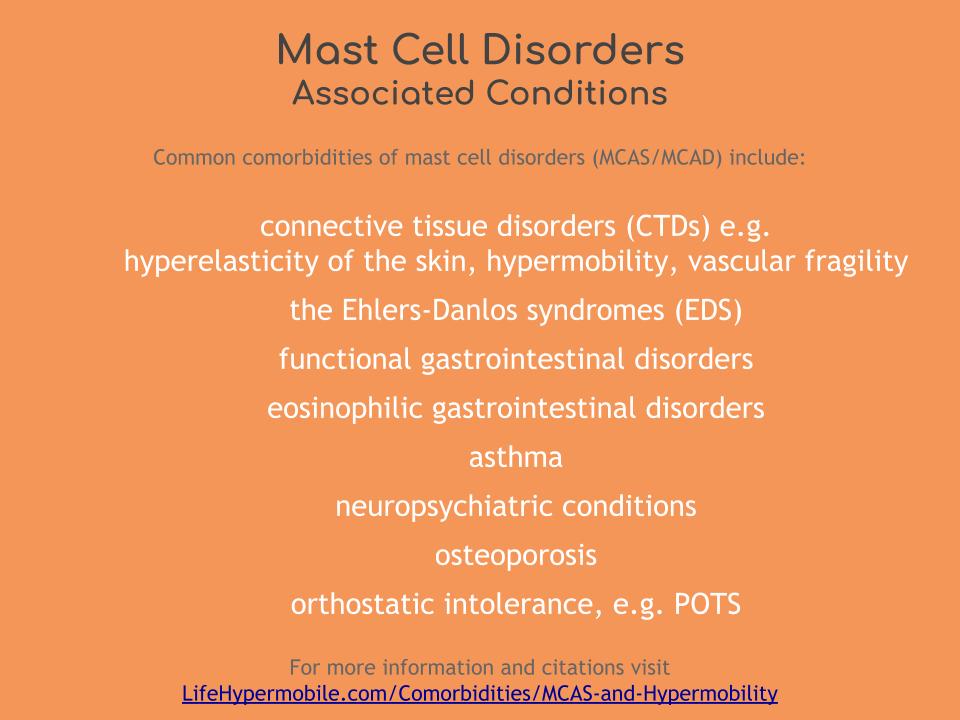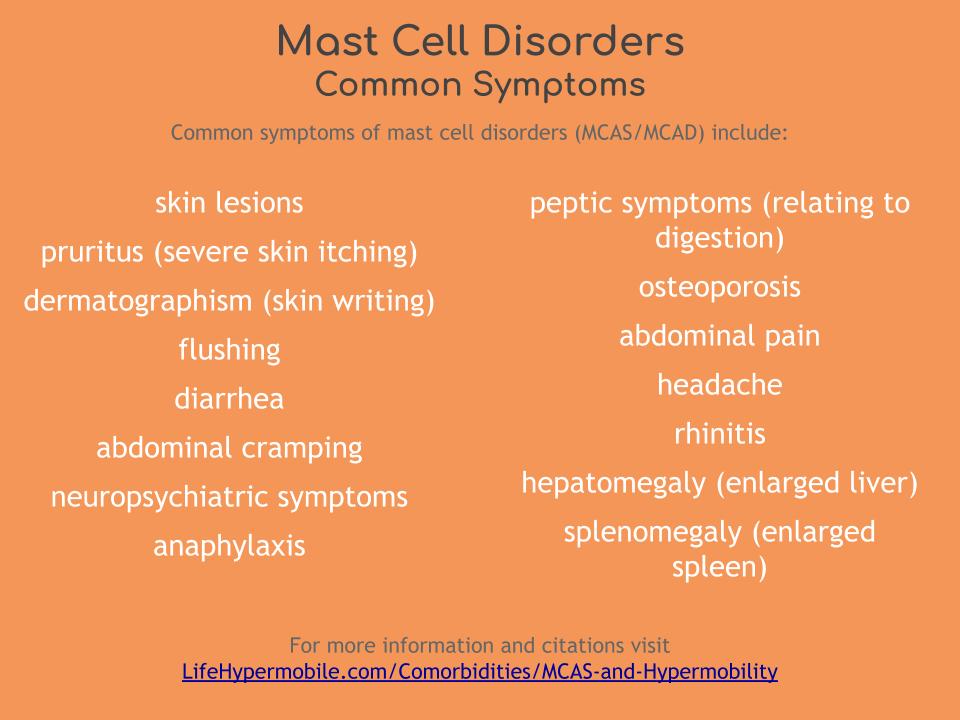What is Mast Cell Activation Syndrome?
A really great website for learning about Mast Cell Activation Syndrome (MCAS) is Dr. Jill’s page Mast Cell Activation Syndrome (MCAS): When Histamine Goes Haywire…
She’s a woman after my own heart, I think. Her page on this topic is pretty much everything I wish mine could be, including a list of symptoms, beautiful diagrams, associated diseases, lab tests, treatment options, and links to additional resources, including medical journals.
I really, really, really love this diagram she created which links triggers and symptoms:
Histamine Intolerance and Mast Cell Activation Diagram.
She also references an excellent medical journal article, Mast cell activation disease: a concise practical guide for diagnostic workup and therapeutic options.
Mast Cell Disorders and Hypermobility

The best place to start here is with the article Mast Cell Disorders in Ehlers-Danlos Syndrome by Senevirate et al, published in March 2017 with the updated EDS nosology. They note several reports of common co-morbidities, including:
- connective tissue disorders (CTDs) (e.g. hyperelasticity of the skin, hypermobility, vascular fragility, etc.)
- the Ehlers-Danlos syndromes (EDS)
- functional gastrointestinal disorders
- eosinophilic gastrointestinal disorders
- asthma
- neuropsychiatric conditions
- osteoporosis
- orthostatic intolerance
They also mention an article proposing a link between several often co-morbid disorders, “A New Disease Cluster: Mast Cell Activation Syndrome, Postural Orthostatic Tachycardia Syndrome, and Ehlers-Danlos Syndrome,” which I was only able to find an abstract of online. Senevirate et al summarize their findings,
“Cheung and Vadas [2015] suggested a possible new disease cluster: Mast Cell Activation Syndrome (MCAS), Postural Orthostatic Tachycardia Syndrome (POTS), and EDS. Patients having a diagnosis of POTS and EDS were given a screening questionnaire to look for symptoms consistent with MCAS, and 66% of respondents reported such symptoms.”
For more on the genetic evidence that indicates a possible connection between the diseases, please refer to the genetics section below.
The rest of the 2017 article is quite technical and goes into great detail about the different diagnostic criteria, possible causes, and potential treatments. I strongly recommend going over the entire article with a willing doctor to discuss which treatments are right for you, and as always, I advise against self diagnosis and self treatment. The main takeaway from the article, however is that,
“The clinical presentation of MCAD tends to very heterogenous. Clinicians need to be aware of this so as to suspect the condition and carry out appropriate testing.”

Common symptoms to watch out for include:
- skin lesions
- pruritus (severe skin itching)
- flushing
- diarrhea
- abdominal cramping
- neuropsychiatric symptoms
- anaphylactic
- peptic symptoms (relating to digestion)
- osteoporosis
- hepatomegaly (enlarged liver)
- splenomegaly (enlarged spleen)
- abdominal pain
- dermatographism (skin writing)
- headache
- rhinitis
- asthma
As fas as treatment goes, they note that,
“co-morbidity of EDS (any form) is not known to affect the approach to treatment of MCAS, except to note that chronic glucocorticoid therapy (a poor choice anyway in MCAD given the treatment’s chronic toxicities, including in connective tissues) may be an even poorer choice in MCAD patients also featuring EDS.”
and
“An effective “primary” physician – whether a primary care physician or specialist – is critically important for successful management of most complex diseases, including MCAD. The absence of a local “physician/partner” who can reliably help the patient access local health care resources could lead to the patient facing difficulty in gaining and then maintaining control over their disease. Drug treatments need to be tailored to the individual patient.”
The group EDS Awareness at ChronicPainPartners.com has several webinars by leading experts on MCAD/MCAS and EDS, including 3 by two of the authors of the 2017 article, Anne Maitland and Lawrence Afrin:
Mast Cell Activation Syndrome Part 1 by Dr. Anne Maitland:
Mast Cell Activation Part 2 by Dr. Anne Maitland:
Mast Cell Activation by Dr. Lawrence Afrin:
These webinars are quite long, but well worth taking the time to watch if you have these conditions! What I found most eye-opening was the fact that allergic responses are so much more than what you might think. It’s not just runny noses and tongue swelling! Mast cells are all over your body, and can result in a wide variety of symptoms when activated.
Possible Genetic Connection: MCAS, Connective Tissue Disorders, Dysautonomia, FGIDs
Check out my blog post summary of the Chronic Pain Partners webinar “Trypped Up by Tryptase: An Update on Tryptase Research at NIH” by Joshua Milner, MD. He disscussed the latest research on tryptase and it’s association with connective tissue disorders and mast cell activation (although so far no causal relationship has been confirmed).
(more info coming soon!)
Sources
Cheung I, Vadas P. 2015. A new disease cluster: Mast cell activation syndrome, postural orthostatic tachycardia syndrome, and Ehlers–Danlos syndrome. J Allergy Clinical Immunol 135(2):AB65.
Molderings GJ, Brettner S, Homann J, Afrin LB. Mast cell activation disease: a concise practical guide for diagnostic workup and therapeutic options. Journal of Hematology & Oncology. 2011;4:10. doi:10.1186/1756-8722-4-10.
Seneviratne SL, Maitland A, Afrin L. 2017. Mast cell disorders in Ehlers–Danlos syndrome. Am J Med Genet Part C Semin Med Genet 175C:226–236.